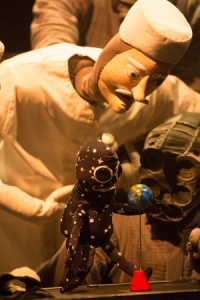Baby Universe starts out dark. Actually, dark may not even be a strong enough term for the mood. Grim. Fatalistic. The last man to escape the Earth’s surface for the safety of underground bunkers is interviewed about the planet’s last days, describing the expanding sun, the burnt land, the dried up seas, and the death of his wife. It’s not what you expect from a puppet show. But after starting in those depths, Baby Universe climbs up, up, up to incredible heights of optimism and redemption. The show is a ‘Must-See’ for the ease with which it shifts tones as much as for the technical expertise that Wakka Wakka bring to their puppetry.

While the core concepts of Baby Universe – dying stars, Earth’s limited resources, and the existence of “baby universes” inside black holes– come straight from the work of Stephen Hawking and other scientists, the play itself is a magical realist fable about death and rebirth. With a dying Sun about to consume the solar system, create baby universes in the hopes of finding a new home for humanity. The universes are literal babies, fostered on women who volunteer to raise the creatures who may be the human race’s last hope. Universe 7001, the protagonist, turns out to be especially promising. This brings him to the attention of the Sun and the various planets, who are aggressively resigned to their fates. If the planets have to die, they want to take the humans with them.
Developed with the Nordland Visual Theatre, Baby Universe is absolutely enchanting, a feast for the senses. Praising Wakka Wakka for their puppet-work almost seems unnecessary; the company has won numerous awards for their work, and been nominated for even more. Let’s just assume that the company knows how to operate their puppets. Where the group pushes above and beyond the average puppet show is the way that they play with light, sound, and scale to build the world on-stage. The lighting design by Alex Goldberg makes room for light-up gas masks, projections, and twinkling stars within the main character. And while Petter Hagen’s music is effective for setting the mood, Brett Jarvis’ overall sound design allows the performers to shine in generating most of the play’s sound effects. But the company’s real coup is their ability to play with the concept of scale. As 7001 grows, he is replaced by larger and larger puppets. But when he is chased by one of the antagonists, the company switches effortlessly back and forth between the full-sized puppets and smaller models to give a sense of the distance being traveled. And when 7001 expands to dwarf the other characters, the same puppet is placed in relation to set pieces that were previously used alongside tiny 7001 models. It’s a simple and utterly effective.
Under the guidance of Directors Kirjan Waage and Gwendolyn Warnock, Wakka Wakka balance three levels of narrative in the production. The first is Apocalypse Radio, a series of interviews with the last survivors of humanity. The interviews, featuring the company members in grey bodysuits and animalistic gas masks, are absolutely brutal. There are some funny moments, but the company doesn’t pull any punches in presenting the horrific state of the world. Apocalypse Radio segments are interspersed throughout the performance, and provide a constant reminder that the stakes are high. The majority of the show, which takes place in the last bastion of humanity, concerns the development of Baby Universe #7001 and his relationship with his mother. Utilizing both hand puppets and larger, bunraku-style puppets to play the humans, this section epitomizes the warmth and humor of the production. I’ve rarely seen human actors portray familial affection as well as the puppets in Baby Universe, and it’s even more impressive when you consider that one puppet represents a lab grown, anthropomorphic universe rather than a human being. The connection between the characters makes it easy for the audience to become emotionally invested. The final level of narrative, and the source of the play’s conflicts, is that of the solar system. While most of the characters here are fairly standard hand-puppets, the Moon’s outsized legs give him a creepy insect-like air, while the Sun… let’s just say the phrase “nightmare-fuel” comes to mind. The Sun’s first appearance was a shock to the system, and one of many moments in the production that set the audience murmuring.

and Nordland Visual Theatre. Photo by Igor Dmitry.
One of the very few issues with the show is that these three narratives don’t fit together perfectly well. Details of the main plot are contradicted by the Apocalypse Radio interviews, while thinking too hard about the interactions between #7001 and the planets is going to end in frustration. To concentrate on these issues, though, is to miss the point. Like any good fairy tale, Baby Universe has a perfect sense of its own internal logic. The jokes never seem out of place or forced amidst the drama, and problematic plot details are secondary to thematic consistency.
Baby Universe knows where its heart is, and that, in the end, is what truly makes it a wonderful hour of theatre.
Running Time: 60 minutes, with no intermission.
Baby Universe plays through July 14, 2013 at Wakka Wakka Productions at The Studio Theatre – 1501 14th St. NW, in Washington, D.C. For tickets, call the box office at (202) 332-3300, or purchase them online.




